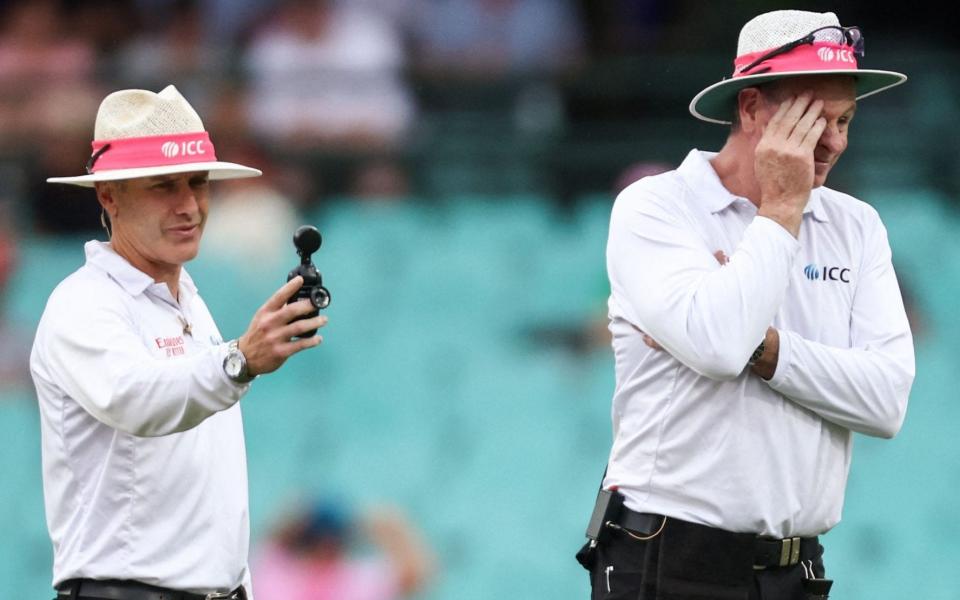The end of 'bad light stops play'? Australian players lead calls for new ball

Cricket authorities are under growing pressure to find a solution – possibly involving adapted balls – to maximise play in fading light, after fans were left frustrated by players being taken from the field in Test matches in both Sydney and Karachi.
Pakistan’s two-match series against New Zealand ended in a 0-0 draw after the umpires took the players off three overs early on the final day of the second Test. At that point, Pakistan were nine wickets down, just 15 runs shy of their target of 319, with their numbers 10 and 11 surviving 21 balls at the crease. The final five overs of the match had all been bowled by spinners, with all New Zealand’s fielders round the bat.
This drew fierce criticism from cricketers and fans, with Scott Styris, the former New Zealand all-rounder, tweeting: “Both teams had a chance of winning and we come off the field with 3 overs to go. Exhibit A of why Test cricket is in trouble. Zzzz [sleeping emoji]. Well done both teams for battling all the way.”
There was also criticism of the state of play in Sydney, where the first three days of Australia’s Test against South Africa were beset by poor weather, including bad light.

Steve Waugh, the former Australia captain, had been critical of the lack of play on the opening day of the Test match.
“Test cricket needs to realise there is a lot of competition out there and not using the lights when the players are off for bad light simply doesn’t add up,” he posted on social media on Wednesday. “Lots of unhappy spectators who can’t understand the rationale and reason for no play. #commonsense #movewiththetimes @icc @cricketaustralia.”
'The ICC aren't doing anything'
Todd Greenberg, the chief executive of the Australian Cricketer’s Association, said his organisation would look at investing in balls that could be seen in fading light.
“I want to talk to them about it and say what else can we do?” Greenberg told the Sydney Morning Herald. “Who can we partner with? How do we work this out? Because what I’m learning quickly is the ICC aren’t doing these things. There’s no-one in cricket doing this stuff, so there is a void.
“And in the absence of someone else doing it, I’m going to call it and say, well, we should do it. Let’s do it.
“We can’t just sort of sit around and whinge about the fact we’re not on the field, we’ve got to find something to do about it. Are we genuinely with research and development trying to find solutions? And if we’re not, the players will get on the front foot and we’ll spend some money, and we’ll do something because we’re got to find some solutions. It’s just not good enough that we weren’t playing.”
“If we’re genuinely going to compete with everything else [in the entertainment industry], we can’t walk off because of bad light,” Greenberg said.
“So what are those solutions? Is it a pink ball? I understand why everyone will shout me down and say no, but is there a better technology in the availability of the ball that allows us to stay on the field? It has to be otherwise we’re going to be this sport that’s caught in yesteryear.
“I can’t ask the players to go out and face a ball at 150kph, it’s not safe. We’ve got to spend some time and money and energy to find solutions. And it has to be a solution to get the players back on the field.”
In England, Daryl Mitchell, the Professional Cricketers Association’s COO, told Telegraph Sport that it was the responsibilities of governing bodies, not players, to find solutions.
“It’s the most frustrating thing in the game for fans, players, umpires, everyone,” he said. "Bad light is a nightmare, but equally player safety is paramount. All credit to the ACA for seeking a solution, but it probably shouldn’t be their responsibility, it’s boards who choose which ball is used. I would have thought the responsibility lies with them and the ICC.”

 Yahoo Sport
Yahoo Sport 



































































